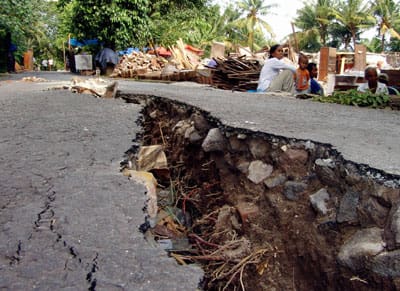.gif&w=556&h=133&zc=1)
WARNING: Don’t Be Fooled by Earthquake Lies!
“Get Out of That Doorway!” and Other Useful Tips For Living in Earthquake Country
You’ve probably been hearing about earthquakes all of your life. But how much of it is true?
We will separate fact from fiction in this top 10 list of common earthquake myths!
- One common earthquake myth is the idea of “earthquake weather”. In the wake of the most recent heat wave in Los Angeles, residents might be concerned that the hot and dry weather could spell disaster and indicate a large quake to come. This, however, is not true. Earthquakes can come at any time and during any type of weather, so it’s best to be prepared no matter what!
 Another “fact” that has been passed off as truth is that bigger earthquakes happen in the morning. Although some people may have seen this to be the tendency, it is not certainly not the rule. There have been plenty of notable earthquakes that have occurred in the afternoon and evening time and, just like the weather, time of day has no bearing on the chance of an earthquake striking, nor can it determine the magnitude.
Another “fact” that has been passed off as truth is that bigger earthquakes happen in the morning. Although some people may have seen this to be the tendency, it is not certainly not the rule. There have been plenty of notable earthquakes that have occurred in the afternoon and evening time and, just like the weather, time of day has no bearing on the chance of an earthquake striking, nor can it determine the magnitude.
- Megaquakes are another bit of earthquake lore that you might have been led to believe. Any quake over a magnitude of 10 is considered “implausible” by most scientists. This is because there is no known fault long enough to be able to cause an earthquake with a magnitude of over 10.5. For example, the most well-known fault in the U.S., the San Andreas Fault, is only 800 miles long, which could not possibly cause such a strong quake.
- You may be familiar with the TV and movie trope of an animal with an extra special sense for such things as bad weather or if Timmy is trapped in the well. While this looks good on television, it is not really applicable to real life. Studies have shown that there is no correlation between unusual animal behavior and the onset of earthquakes. While Fido or Fifi might be able to feel a smaller magnitude of earthquake that we as humans cannot, they are not reliable predictors of an earthquake to come.
- Just as animals are unable to predict earthquakes, so too are humans. While scientific researchers are able to record and analyze earthquakes as they happen, there has been no proven case where an earthquake has been predicted before its occurrence.
- Another disaster movie scene that you may be familiar with is that of the ground opening up and swallowing people in the throes of a major quake. Again, though this may look good on the big screen, it is not actually possible. This is because the earth moves across a
 fault and not away from it during a quake. If the fault were to open, there would be a lack of friction and therefore a lack of earthquake.
fault and not away from it during a quake. If the fault were to open, there would be a lack of friction and therefore a lack of earthquake.
- Yet another popular earthquake horror story is the one about an earthquake that is so large, it causes California to break apart from the rest of the U.S. and fall into the ocean. As much as some people might even welcome this, it will never occur. The movement of California is horizontal along the San Andreas fault and north towards Alaska and the golden state is nowhere near breaking off from the rest of the country and sinking into the ocean.
- Probably the most popular of the earthquake “advice” people have been doling out over the years is the good old, “Stand in a doorway!” direction. The truth is that you are much safer under a table than you would be in a doorway. Most modern buildings are built so that the doorway is not any stronger than the rest of the structure and there is even the chance of injury by the swinging of the door in a doorway. Ouch!
- Many people believe that strict building codes mean strong buildings. While this is true for many buildings built recently, it does not take into account the myriad of older buildings in existence that were built under older and less stringent building codes. The responsibility of retrofitting lies with the owners of such older buildings in order to be bring their property up to code and keep everyone safe.
- The final myth is the idea that everyone will be in a panic in the event of a massive quake. Luckily, while the idea of an earthquake is scary for many, research has shown that most people remain calm and collected during this type of emergency rather than running around screaming and losing their minds. Proper preparedness and protection now will help you in the future should the next big earthquake strike.
Sources:
http://earthquake.usgs.gov/learn/topics/megaqk_facts_fantasy.php
http://www.consrv.ca.gov/index/earthquakes/Pages/qh_earthquakes_myths.aspx
http://www.scec.org/education/public/allmyths.html
http://www.nbclosangeles.com/news/local/Earthquake-Myths-172886441.html
